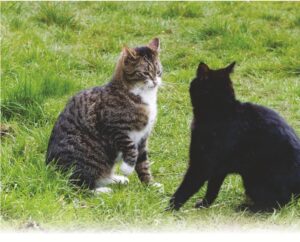Claws Out to Claim–
Handling Feline Territorial Aggression
Indoor cats establish territories just like their wild counterparts. It is important to keep in mind that at the end of the day, cats are predators whose instincts still reign supreme.

Cats in the wild usually have large territories based on the availability of food sources. They regularly patrol their territory too. Wild cats are solitary creatures and try their best to avoid accidental confrontations with other cats. They hunt alone and thus, their ability to survive in the wild is dependent on their hunting ability.
By marking their territory, wild cats that can tolerate each other reach an arrangement to share resources in a particular area without needing to battle it out. Different cats stake their claim over the same space at different times of the day. This is also referred to as ‘timesharing’.
Safety from external threats and consistent access to food sources are the two most important requirements of cats. If these requirements aren’t met, their instincts can manifest in the form of territorial aggression.
How do cats mark their territory?
Territorial behavior in cats can show up in many ways. Cats are particularly sensitive to smells and hence, more likely to use their scent to claim ownership of their territory. Rubbing the chin on a plethora of household objects usually does the trick. Urine marking is another territory marking tactic that’s used to warn potential invaders to stay away. A cat’s urine can reveal a lot of information about him to other cats such as his approximate age, gender, health condition, and the time he last visited that spot. Urine marking is done frequently by cats sharing a territory.
Staring, blocking doorways in the house, hissing, growling, stalking, etc. are some of the manifestations of feline territorial aggression. Things start to get ugly when cats display dangerous symptoms such as clawing, scratching, and biting.
Handling territorial aggression in cats
 Underlying medical issues are often known to cause discomfort and territorial aggression in cats. Regular health check-ups by the veterinarian will help detect problems early and deal with them better.
Underlying medical issues are often known to cause discomfort and territorial aggression in cats. Regular health check-ups by the veterinarian will help detect problems early and deal with them better.
Non-neutered male cats are more likely to display symptoms of territorial aggression, although most cats who have reached sexual maturity exhibit such tendencies. Spaying and neutering pacify the raging hormones and greatly reduce the chances of your cats becoming aggressive.
Train them to tolerate
Exposing your cat to different types of social and environmental stimuli from an early age can greatly reduce her predisposition to become aggressive once she matures. By using positive reinforcements and rewards, a cat can be trained to be more tolerant of other cats in her vicinity.
Musings of multi-cat households
Multi-cat households are more susceptible to witness the eruption of territorial tension. In a wild setting, cats stay together with preferred ‘friends’ while the others are expelled from the group. However, indoor cats are forced to share space with other cats, including the ones they dislike, and territorial aggression is their way of acting out against this unfair arrangement. The more two cats fight, the more fraught with tension the equation between them will be. In the case of catfights, prevention is certainly better than cure.
Pet parents wanting multiple cats should opt to get two kittens from the same litter as they will be easier to manage. Cats are notorious control freaks and so, the arrangement in a multi-cat household should allow each cat to have adequate control over their environment. There should be ample space for them to escape in case the hustle and bustle of the household makes them anxious. Multi-layered vertical cat perches can be added to make use of the household space between the floor and the ceiling, while also reducing the visual confrontation between the cats.
A quiet and protected enclosure like a cardboard box with holes and soft bedding inside will be a great retreat option for a high-strung cat. Additionally, provisions should be made for multiple litter boxes, food bowls, and water bowls in several places of the house to prevent dominant cats from intimidating the shy ones.
Curb the catfights
Staying alert about the initial signs of territorial behaviour in cats, like staring, growling, etc. can help you intervene before an actual fight starts. Clapping, banging on plates, or making any other noise can help momentarily startle and distract cats that are engaged in fighting. Spraying water on them or throwing a blanket on them can also help break them apart and disrupt the fight. Do not use your hands to pick up or separate two fighting cats as you may end up getting scratched or bitten.
Nuances of introducing a new cat
Introducing a new cat to a household that already has a resident cat, or re-introducing a cat that has returned after spending a significant time elsewhere can be an uphill task.
A systematic desensitization process is employed to mitigate stress between cats that do not get along with each other.
The process entails the following steps –
- Keep the cats in completely separate parts of the house with their exclusive food bowls, water bowls, bedding, litter boxes, and toys.
- Reverse the cats’ locations to expose and get them used to each other’s odor. Offer their favorite treats to help them associate the stressful stimuli of the new location and the unfamiliar scent with something positive.
- Keep the cats physically separated, but allow them to see each other through a barrier such as a mesh door. Give them treats to encourage them to associate meeting each other with something positive.
- With sufficient restraint, allow the cats to physically access each other.
Allow the cats to take as long as they please to get accustomed to each other’s presence. This is a transition you simply cannot afford to rush. If you have multiple cats, reinforce a positive bond between them by giving them equal attention and affection. Wipe them down with the same damp cloth to get them used to each other’s scent.
All they need is safety and sanity
Sometimes, just being able to see or hear other outdoor or neighborhood cats through the window is enough to trigger and agitate your cat. Remove any window perches, close the curtains, and block her window views to prevent her from seeing other cats. Keeping your cat indoors and providing her with a fun new toy or cat perch can also be a good way of distracting her.
Cats need predictable environments to stay sane and can get easily disturbed if there is any change in the usual routine or environment. Even small, seemingly insignificant changes like redecorating your living area can be enough to upset a cat. Try sticking to a regular schedule of feeding time and playtime. Ensure regular cleaning of their litter box. Do not keep changing the location of their beds, food, and water bowls or perches around. The fewer things around them change, the calmer your cats will be.
Hope these tips help you and your feline(s) in happy co-existence!

